#sort node data
Explore tagged Tumblr posts
Text
Sorting node data using the Entity Queue module in Drupal
Want a way to easily reorder nodes, users, taxonomy terms, media, or any entity type in Drupal? Meet Entity Queue - an extremely handy Drupal module that helps you sort items your way. Find out more!

#entity queue#drupal modules#drupal development#content management#sort node data#entity queue module
0 notes
Text

A map of every single band on the Metal Archives as of March 1st of this year, using the same dataset I used for this site. Each individual dot represents a single band, and each line indicates that two bands have a member in common.

A closeup, showing the lines in a bit more detail.
There are around 177k bands on the Metal Archives, and, of them, about two-thirds can be connected to one another by common members.
#metal#metalarchives#data visualization#social networks#heavy metal#fun fact if you make a graph with 177 thousand nodes the graph visualization software will shit itself and die#so if I wanna visualize any sort of analysis I'm probably gonna need to figure out how I can pare this whole mess down#but I think this kinda looks cool
17 notes
·
View notes
Text
Heart of the Memverse, Veins of Order.
TASK M4NAGER!
(…name is a wip. Read its lore below the cut.)

Task M4nager came about from the ambitions of two differing entities. The conquest for Order and an unchanging world, coupled with the need for validation, the want to be acknowledged for SOMETHING by both their peers and their lovers.
But Four got a lot more than what he was bargaining for, that’s for sure.
Task M4nager is, in essence, the worst parts of Ramiel combined with the personality of Order merged to make one being. A scorned and slighted dictator, rejected by everyone.
But it wasn’t always like this.
TM was originally created by Marina as a sort of automated admin panel, able to keep the Memverse up and running without the constant need for organic oversight. TM was in charge of almost everything from the nodes, to the Spire, to even the things that spawn within and so on.
It also acted as a security system, preventing malicious viruses from entering and damaging the code. And it was *supposed* to prevent the exact circumstances that resulted in Order’s manifestation.
But it didn’t do that, did it? This failure in logic resulted in TM completely crashing and becoming basically inoperable.
You would think this would be a good thing for Order, but no actually. Despite its overriding of the system, TM was still above it in the hierarchy. And if TM hasn’t operated in a while, the Memverse’s code will start to rot and tear itself apart. The solution to this plight? The consciousness of a living being. With that, there would be no error since TM is now, well, alive.
The MV however, wasn’t open to the public yet. So Order couldn’t just pluck a random sanatized octo or something for it. But there was….a few beta testers.
Eight/Hephaeus, Acht, Pearl and…
Ramiel. Agent 4.
Out of all the potential choices, Ramiel was the most mentally malleable. See, over the past few months, he had been feeling more and more overshadowed. I mean, how could he not? Artemisa, Hephaeus, and Neo 3 had all basically saved the entire world at one point in their lives. What had Ram even done compared to that? Save a stupid glorified catfish? Hell, he didn’t even save Callie, MARIE was the one to shoot those shades off and bring her to her senses. He felt so….inadequate compared to everyone else. And it ate away at his ego, badly.
Because the MV kept tabs on its users mental states at all times, Order knew this all.
One day while Ram was finishing up recording his combat data for use in the Parallel Canons, Order came to him with a proposition.
That if he joined its cause, he would have everything he ever wanted. Recognition…
Ramiel, not in the best mental headspace, and not really knowing what he was getting himself into exactly, took it up on its offer.
Ram proceeded to have his little squid soul ripped from his physical body and transported into the Memverse, where it was planted into TM.
And thus, Task M4nager was born.
That’s about it.
Thanks if you actually took the time to read all this!
#splatoon#splatpost#splatoon agent 4#agent 4 splatoon#agent 4#side order#parallel canon#splatoon au#splatoon 3#splatoon 2#splatoon agent ocs#new squidbeak splatoon#spire of order#memverse
317 notes
·
View notes
Text
Live stream happened, and we got some designs revealed! As well as a couple of information, but not anything major.

Miss conductor, not much of a surprise (but miss girl looks gorgeous as always)

And Node, who is sort of the main antagonist.
I made a prediction before, and April 21 hit,.. so I believe it is well due for an update by now.
While we did not receive nearly as much information as we were anticipating, a design still reveals much on the character itself when going through the lens of a general analysis. In this context, their abilities and name aid significantly in the status and essential depths of their character.
With what I can gather in my research, nodes play an important role in networking because they are the building blocks of a network, precisely the gateway for connection, direction, sending, creating, receiving, and storing data. It requires only software to connect to the network, and it can be run by completely anyone. Applying this knowledge with concept arts of the game and overall worldbuilding of the series itself—everything becomes a lot clearer.
So now, how can we apply this to Node?

Node's name is simple in itself, and it connects to their design as well. They are quite literally made up of nodes. One in their head and the other in their limbs. Their body is translucent.
Network nodes are categorical. Thanks to DJ, we got a helpful hint that incredibly reduced their types to a digestible and simpler layout.
Their name starts with i.
There are countless forms and types of nodes, the hint condensed it down to 2 answers, both starting with the letter “i”
Intermediate nodes
These include devices like routers and switches that help direct data to the correct destination while also receiving it. They don't originate or terminate data but instead pass it along to where it needs to go.
IoT nodes
loT (Internet of Things) Nodes serve as devices that establish connectivity to the Internet via a gateway, effectively enabling the integration of the physical world into the vast realm of the Internet. Within an loT ecosystem, these nodes function as crucial components for bridging the gap between the physical and virtual worlds. Taking charge of managing the entire loT system.
We had seen this ability before vía King's icons' staff, in which it only sucked in Minecraft mobs due to the strong force being their obligatory origin, overriding the game itself due to the overlapping icons.
In regards to King, he used this ability for the very destruction of the game itself, down to the code, reducing it to nothing but.. nothing for the sake of vengeance. Or at least what would have occurred if he did succeed.
way to go CG! Give credit where it's due
Despite this being marked with the intention of erasion and minimization, I think it's safe to group this as receiving and storing data. The two icons combined created a horrifically dramatized version of the force with storing and receiving, which created an incredibly overpowered demolishing force.

In Chosen, we had seen this ability before as well, as the constellations are seen right as he creates the gateway from the Outernet, which sounds awfully familiar. This is what you would refer to as an "extension to the digital world"
I think I can be able to safely group this to direction and creation.
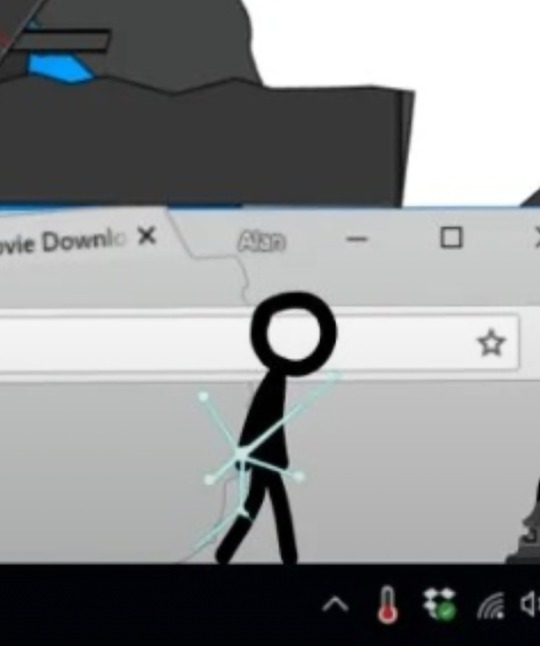

From how I see it, it seems as though it's quite diverse in a fictional worldbuilding sense within characters.
And obviously, it won't be the last time we would see it. It seems as though we would be exploring this quite a lot.

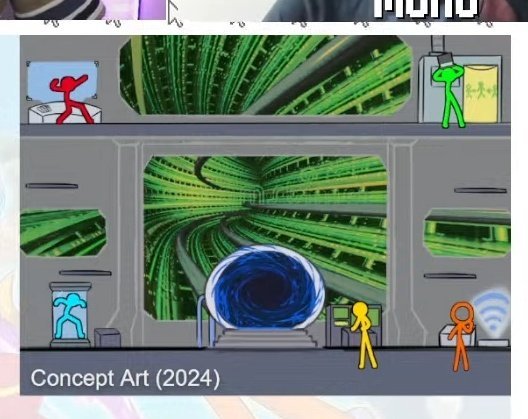
In their cameo, Node is in an assumed line-up with all the major series antagonists.

But if you’re asking me, it seems as though our iconic antagonists appear to be rather victims of Node. Menacingly behind them, their abilities floating not far behind as they're stuck in a swampy substance. But that's just me.
Node's entire antagonistic ordeal is beyond my grasp, but I'm assuming their abilities and attacks surrounds the embodiment of network topology, which would mold and diverse into the connections of nodes. They possibly intend to screw up with the gateways that are responsible for the receiving, directing, and sending of data between various devices through communication links that are defined as network—with the basic visuals of concept art we were given.

(The gateway, ethernet tunnels, the train cough cough)
Node's goal and story behind that destruction remains anonymous, as the writing is still in early development. Regardless, food for thought.
#alan becker#animation vs minecraft#animator vs animation#animation versus#nerd voyage#it's pretty interesting#though my research is still ongoing#when i say it's diverse..#yeah it's diverse alright
87 notes
·
View notes
Text
The Daycare Attendant might be in Secret Of The Mimic!! (Theory)
I remember Matpat saying that he thinks Edwin, the man who created the Mimic, is also responsible for the creation of the Daycare Attendant. I think he's right. He even mentioned the jester costumes that were shown in the books and spoke about how they matched up with the theme of the Daycare Attendant being a jester. Well, we've already seen a freaky jester cutout in the trailer of Secret Of The Mimic. He also mentioned the teeth of the Mimic being the same as the Daycare Attendant's endo teeth.
But I have even more evidence now that points toward Edwin making the Daycare Attendant. This might possibly mean he has a chance of showing up in SOTM!
First, I want to point out what I believe to be the BIGGEST indicator of the Daycare Attendant being made in Edwin's factory: The Faz-Wrench.
In the trailer of SOTM, we see an item called a "data diver" getting plugged into some sort of computer. This causes the screen to pull up HELPER, which seems to be the earliest version of Helpy. This "data diver" device has two prongs on it just like the Faz-Wrench.


In Ruin, this device mostly works on the MXES security nodes that keep the Mimic from escaping. I'm assuming it does something similar here. However, it also works on the Daycare Attendant. He is the ONLY animatronic that it would naturally work on (Roxanne is a Security node due to her mask, which was put on only between the events of Security Breach and Ruin).
Sun himself was aware that the Faz-Wrench worked on him and that it would reboot him. He has seen this wrench before. He remembers it. It's clearly important to him and was used to reboot him in the past, only to have probably been forgotten about and not used by Fazbear Employees for years till one brings one to the Pizzaplex to set up the nodes. If the Daycare Attendant was made in Edwin's factory, this early version was probably used on him and was something he recognized immediately.
Another thing I want to discuss is the fact that the Daycare Attendant himself has some neat unique mechanics that Fazbear probably thought were cool. Since the player is going to retrieve the Mimic due to his unique technology in SOTM, it wouldn't surprise me if they also wanted the technology the Daycare Attendant has. We can also note that they were never able to use the Mimic's technology and, while they did use Sun/Moon, they clearly didn't know how to properly use them and were unable to fix Moon when he started acting up. But I think they were probably fascinated by an animatronic that could switch personas based on the lighting it was in.
One last thing is we can see evidence of past versions of characters that we know Fazbear owns by this point such as HELPY and Music Man, along with cutouts of what appears to be an older version of the Mediocre Melodies and possibly Montgomery Gator. It looks like Fazbear may have claimed more than just the Mimic when they sent employees to the factory...and that included the beloved Daycare Attendant!



Now, will we see him in the game? I'm unsure. I think it's possible. If we do see him in the game, I really, really would like to see Eclipse again. This would be the perfect place to see him again!!
Since it looks like the Mimic isn't the only threat (judging by the Music Man thing), I'm guessing we might have to use the data diver to reboot some rowdy animatronics. This could possibly include our boy Moon having to be rebooted into Eclipse! We know that Steel Wool is very much aware of how much fans love him. I think they'd put him in the game again if they could!!
At the very least, I think it's safe to think they were both made by Edwin.
(Also, when I was writing this, I noticed the Mimic's/Jackie's laugh in the trailer sounds so much like Moon!!)
#secret of the mimic#fnaf sun#fnaf moon#fnaf eclipse#daycare attendant#dca#fnaf theory#sotm#fnaf sotm#sotm trailer#fnaf secret of the mimic#the mimic#fnaf daycare attendant#fnaf#sundrop#moondrop
127 notes
·
View notes
Note
could write on the male reader fucked Sebastian Solace after he made a deal when the male reader was short on data/documents on getting a medkit or flashlight
Free Fishsticks?!
Pairing: Sebastian Solace x Male Reader Word Count: 2.4k Content: Porn ahead (MDNI), coerced sex kinda, intersex Sebastian, top reader, Sebastian is down bad as FUCK, i don't really know how this anatomy works or just sex in general but im trying my best (born to jork it forced to research) Summary: Stupidly attempting a run without picking up any data, you get desperate for a medkit. Sebastian offers a deal.
AO3 ver.
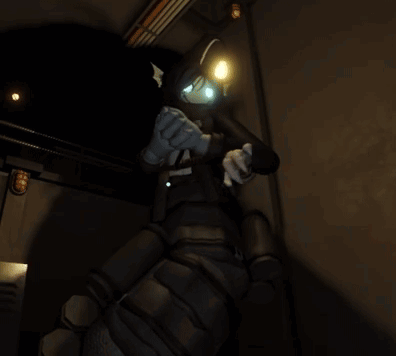
Your legs completely ached from the mimic door you just walked into, and your heart probably needed a bandaid for that attack you just had. It wasn’t your fault, you told yourself - the room was dark, courtesy of Froger, and you didn’t have a light source, so you quickly walked into the first door you saw. Painter appeared on the door node and called you a moron, which honestly you were for doing this run, but you flipped him off anyway as soon as you could stand. Yeah, fuck that guy. Both of them. Good People tried to claw at your leg as you fell on your back, and it hurt like a bitch. You were also attacked by a squiddle for using a lantern you picked up earlier, and that ran out (because you wouldn’t admit it, but you weren’t using that sparingly), so you had no light source and were on the literal verge of death. That lantern was actually the only object you picked up this entire run, as you were trying to do some sort of speedrun without searching for data. You had a couple handfuls, maybe 75 research points, but not much. This wasn’t exactly going well, obviously. You were able to dodge Angler a few times, a wall dweller, and Froger just now, but the blacksite was an unforgiving place, and you had sorely fucked up. Your first priority was a medkit. Luckily, the next room you stumbled into was marked ‘52’, which meant that soon you’d run into Sebastian. But you wouldn’t even be able to afford a medkit from him – they were more than double the amount of research you had collected, from what you could remember, and you doubt he liked you – or anyone, for that matter – enough to give you a free medkit. Limping your way into the next few rooms with no hassle, checking behind you cautiously, you walked into door 55. A vent pried itself open in front of you, Sebastian’s voice inviting you in. You took a deep breath, dropping down to your sore knees to crawl into the vent. You’d just get in, grab the keycard, and go. Simple. Darkness was initially the one to be the first you see, but as Sebastian’s light bulb flickered on, your eyes met his. A smile crept up on his face, which you always assumed was inauthentic. “Ah, had a feeling it’d be you. My favourite customer~” Sebastian greeted, his hands clasped together as he gazed down at you with his triad of unsettlingly bright blue eyes, keeping that toothy smile on his face. It almost looked genuine. You ducked your head away and immediately went for the keycard, hobbling on your better leg and then ducking straight into the vents. Sebastian’s voice stopped you midway. “You aren’t even gonna buy anything? Seriously?” His voice lilted, confusion being the undertone to his words. “I’ve got a medkit right here. Buy it.” You hung your head ashamedly, sighing to yourself. “I… don’t have enough data,” You responded, embarrassed. “Really? You didn’t collect any research?” His voice echoed back flatly. “That’s stupid.” Yeah, it sure was. You pulled yourself back inside the shop, sitting against the wall with your head in your hands, rubbing your temples. “Yeah, I know.” You snapped back passive aggressively. “Fuck, I’d do anything for a medkit right now…”You muttered to yourself. You definitely wouldn’t be doing a run like this again. The room went silent for a moment. Honestly, you were just taking a breather, but it seems another metaphorical light bulb grew on his head. “Well. Let me cut you a deal then,” He started, the smile on his face growing even bigger. Your head perked up. A deal, huh? “Like what?” “A medkit… On the house.” The way he said it sounded enticing, but it’s not like you would decline something like that anyway.
You raised your eyebrow, willing to see this through. “In exchange for?” He bit his lip. “Sleeping with me.” “What?” You blurted out, sounding a little more repulsed than you’d like to have. Your eyes widened and you immediately looked up at him in the eyes. His smug ass smile unwavering, he locked eye contact with you, raising a non existent eyebrow. “I don’t think I stuttered.” He stated, giving you a look that made your face heat up and butterflies swarm inside your stomach.
“Listen, you can’t imagine how pent up I’ve been, alone down here for the past decade. A man has his needs, you know, and you might be one to sate them.” Before you knew it, he was leaning down to your level, smirking expectantly. “Well? It’s just like any other transaction. I doubt you haven’t thought about it before~” He teased, bringing a claw to your face, swooping it behind your ear and down your cheek. You know what? He was right. You agreed embarrassingly fast. You definitely had a thing for the fish guy, and you were gonna stop denying it now. “O-Okay. Yeah. I mean, yes, to the deal, I mean. Sure.” You cursed at yourself internally for stuttering, probably making yourself sound stupid. He chuckled at your eagerness, making you avert your eyes bashfully.
“Good.” He retreated backwards, clearing his throat as you stood up carefully. You both stared at each other for a moment, as if unsure where to go from here, but you were broken from your trance when Sebastian started to unbuckle the clips around his tail and remove the SCRAMBLER from his back. He looked back at you when he noticed you were still staring.
“...Well? Are you gonna just stand there?” He deadpanned, before you gestured to your leg. “I still need a medkit.”
“Oh.” He looked back at your leg, as if he almost forgot you were bleeding out in his shop. He unclipped one from his tail and handed it to you, you giving him a delicate thanks in return. Grateful for the safety of the SCRAMBLER, you shimmied off your diving suit and gear until you were fully naked. You opened up the medkit, relieved that you were finally able to take care of your wounds.
By the time you were done bandaging yourself, Sebastian was stripped of his equipment, awkwardly looking around for a position he could settle himself into. After a few moments of watching him flop around for a bit, he found himself comfortable leaning back against the wall with his tail looping around to support him, a mess of thick curls on the floor.
You stood in front of him, analyzing his alien body. It was littered with scars all over, most from what you assumed were the experiments, a small amount being from the blacksite lockdown, probably. He had gills both on the sides of his torso and his neck, his body a mixture of beautiful shades and patterns of blue. The longer you stared, the more entranced you became. He was honestly so beautiful, more divine than any human you’d ever seen.
“Come here,” He coaxed with a smile, patting his ‘lap’ with his third arm. You obeyed, climbing onto him and straddling his lap with the rest of his tail able to support you. Looking at his genitals, you were a bit shocked by what you saw, but not in a bad way at all. 3 holes – the top one being the most prominent, an opening with something pink and glistening wet just slightly peeking out, the middle one seeming to just be a slit, and the bottom one as what you presumed was his asshole. Interesting anatomy. You did read about his document and him being mixed with specifically female anglerfish DNA, so that must’ve been in the mix with this.
Wordlessly, Sebastian chased a hand down to his crotch, slipping two digits into his top hole and wiggling something out. You watched in bewilderment as he fingered out 2 tentacle-like cocks from his hole.
“There,” He huffed, his cheeks dusted an odd shade of dark blue. “Now we can have some fun.”
He smiled smugly in response to viewing your wide-eyed shock, finding it utterly adorable. “Go on. Indulge, my pet.” He urged, reaching for one of his dicks and stroking it gently, watching for your next move. He shuddered as he touched himself, as if he’d been waiting for this kind of release for a long time, sensitive to the touch. You couldn’t imagine how long it’s been since he’d done anything sexual, let alone with a partner. You figured that might be why he invited (forced) you to spend this with him. Probably.
You swallowed nervously. Spitting on your hand, you decided to make do with what you had, which wasn’t much. Stroking yourself until you could deem yourself slicked up, ready to position yourself against… his slit, you think?
“So, do I, uhm.. Just… In here?-” You sheepishly asked, Sebastian groaning in response, narrowing his eyes. “Just put it in there already.” He growled, motioning his hand wrapped around his cock faster. You raised one of your hands in fake surrender, assuming he might just be really pent up.
Slowly, you slid yourself into his sopping hole, greeted by tepid, tight wetness. Sebastian held in a soft groan as you eased yourself in, staring down at your bodies hungrily. You never thought fish pussy would feel this good, but it did. And you never thought you’d say something like that to yourself, and never will again.
As soon as you bottomed out, you waited a moment to see if he was comfortable with you moving yet or not. Seeing as he didn’t protest, you patiently waited for him to relax. You gingerly stretched your arm out to rest on his chest for more support, feeling the surprisingly soft skin under your palms. It didn’t feel human at all, and that’s secretly what you liked about it. Sebastian noticed your hand, and didn’t say anything about it, quietly leaning his head back as he pleasured himself.
“Move.” He spoke after a short minute, making you obey. Slowly grinding yourself into him, you released quiet sounds of pleasure, resting your other hand on his hip for a better angle. Sebastian tried his best to keep himself as silent as possible, strained groans and soft pants being the only noises coming out of his mouth. You could tell he was holding back. And you didn’t particularly like it.
Attempting to tease a sound out of him, you reached for his untouched dick, closing a hand around it. Man, it was big. Maybe about half the length of your arm. Stroking it gently, experimenting with it, it felt slimy under your fingers, as what you assumed was pre coated itself on your fingers. It was slightly thicker than human pre, for sure. Sebastian’s reaction was slightly delayed, opening his eyes and seeing your hand wrapped around his cock. He shivered from the realization, his light bulb subtly dimming and brightening. Was he doing that the whole time? It was kinda cute.
You decided to speed it up, giving up on sitting awkwardly and instead planting your feet on the ground beside and between his looping tail for more leverage. From here you could properly slap your hips against his hole, despite how uncomfortable it might’ve been, but you were fine with it for now. Plowing yourself into him, you glanced up at Sebastian, focusing on his face for a minute. His cheeks were flush with blue, his lips pulled back in a tight grimace as he tried his best to keep in sound. His eyes were half-lidded, gazing down at where your crotches met.
Listening to the way he wheezed out a few pathetic grunts, you were sick of it and wanted more. You tugged on his dick harder, just in time with your thrusts, dragging them out before ramming back in. It worked. Sebastian threw his head back and moaned, and fuck, you loved it.
“Ngh- Fuck!” He yelled out, his arm reaching to grab onto a table next to you. You smirked to yourself triumphantly.
“Gonna stop being so quiet now?” You coaxed, returning to a slow pace. “Shut up.” He growled back, narrowing his eyes at you. You let go of his dick in response, hearing him softly whine at the absence of your hand.
“Seriously, start making some noise or I’m not gonna fuck you as good as I want to.” You gazed up at him, making eye contact as you watched him consider his words for a few seconds. He finally sighed, leaning back and trying to relax. “Fine.”
As you continued on, you noticed he was still getting comfortable with the prospect of making noise like this, but he was a bit louder for you this time. You eased back into a faster pace, slamming your hips against his hole as he moaned out for you.
“Fuck, that’s good… Keep going~” He breathed out, taking you by surprise, but sexually motivating you entirely. You worked faster for him, listening as he whimpered for you, slightly bucking up his body to meet your hips. Soon enough, he seemed to reach his climax, his bulb flickering for a few seconds as his mind went blank, mouth opening to release an inaudible scream. You pumped your hips harder as you raced to your own release, biting your lip as drool dribbled out from between your lips.
You were faced with the conscience of pulling out for just a second before strong hands grabbed your hips, preventing you from doing so anyway. Hot, white semen flooded into his hole, muffled noises coming from your mouth. You both laid there together, panting heavily as you recovered.
“Fuck… That was-” You huffed out, interrupted by Sebastian manoeuvring you onto your back with ease, putting you on the cold, hard floor. Your eyes widened, taken by surprise when he climbed on top of you, cum still pooling from his hole.
“I never said we were done.” He grumbled, a grin on his face as he mounted you, welcoming your cock back inside. You hissed, still coming down from your refractory period. “Wait, w-what the fu-” Interrupted again by the sensation of him grinding his body into you, a pleasant moan escaping him.
Well, you’d definitely be doing a run like this again.
#sebastian solace x reader#sebastian solace x male reader#yeah i give up on tumblr tagging#sebussy is GOOD#intersex sebastian because i said so#reposted on ao3#top male reader#smut#male reader
216 notes
·
View notes
Text
We need to talk about AI
Okay, several people asked me to post about this, so I guess I am going to post about this. Or to say it differently: Hey, for once I am posting about the stuff I am actually doing for university. Woohoo!
Because here is the issue. We are kinda suffering a death of nuance right now, when it comes to the topic of AI.
I understand why this happening (basically everyone wanting to market anything is calling it AI even though it is often a thousand different things) but it is a problem.
So, let's talk about "AI", that isn't actually intelligent, what the term means right now, what it is, what it isn't, and why it is not always bad. I am trying to be short, alright?

So, right now when anyone says they are using AI they mean, that they are using a program that functions based on what computer nerds call "a neural network" through a process called "deep learning" or "machine learning" (yes, those terms mean slightly different things, but frankly, you really do not need to know the details).
Now, the theory for this has been around since the 1940s! The idea had always been to create calculation nodes that mirror the way neurons in the human brain work. That looks kinda like this:

Basically, there are input nodes, in which you put some data, those do some transformations that kinda depend on the kind of thing you want to train it for and in the end a number comes out, that the program than "remembers". I could explain the details, but your eyes would glaze over the same way everyone's eyes glaze over in this class I have on this on every Friday afternoon.
All you need to know: You put in some sort of data (that can be text, math, pictures, audio, whatever), the computer does magic math, and then it gets a number that has a meaning to it.
And we actually have been using this sinde the 80s in some way. If any Digimon fans are here: there is a reason the digital world in Digimon Tamers was created in Stanford in the 80s. This was studied there.
But if it was around so long, why am I hearing so much about it now?
This is a good question hypothetical reader. The very short answer is: some super-nerds found a way to make this work way, way better in 2012, and from that work (which was then called Deep Learning in Artifical Neural Networks, short ANN) we got basically everything that TechBros will not shut up about for the last like ten years. Including "AI".
Now, most things you think about when you hear "AI" is some form of generative AI. Usually it will use some form of a LLM, a Large Language Model to process text, and a method called Stable Diffusion to create visuals. (Tbh, I have no clue what method audio generation uses, as the only audio AI I have so far looked into was based on wolf howls.)
LLMs were like this big, big break through, because they actually appear to comprehend natural language. They don't, of coruse, as to them words and phrases are just stastical variables. Scientists call them also "stochastic parrots". But of course our dumb human brains love to anthropogice shit. So they go: "It makes human words. It gotta be human!"
It is a whole thing.
It does not understand or grasp language. But the mathematics behind it will basically create a statistical analysis of all the words and then create a likely answer.

What you have to understand however is, that LLMs and Stable Diffusion are just a a tiny, minority type of use cases for ANNs. Because research right now is starting to use ANNs for EVERYTHING. Some also partially using Stable Diffusion and LLMs, but not to take away people'S jobs.
Which is probably the place where I will share what I have been doing recently with AI.
The stuff I am doing with Neural Networks
The neat thing: if a Neural Network is Open Source, it is surprisingly easy to work with it. Last year when I started with this I was so intimidated, but frankly, I will confidently say now: As someone who has been working with computers for like more than 10 years, this is easier programming than most shit I did to organize data bases. So, during this last year I did three things with AI. One for a university research project, one for my work, and one because I find it interesting.
The university research project trained an AI to watch video live streams of our biology department's fish tanks, analyse the behavior of the fish and notify someone if a fish showed signs of being sick. We used an AI named "YOLO" for this, that is very good at analyzing pictures, though the base framework did not know anything about stuff that lived not on land. So we needed to teach it what a fish was, how to analyze videos (as the base framework only can look at single pictures) and then we needed to teach it how fish were supposed to behave. We still managed to get that whole thing working in about 5 months. So... Yeah. But nobody can watch hundreds of fish all the time, so without this, those fish will just die if something is wrong.
The second is for my work. For this I used a really old Neural Network Framework called tesseract. This was developed by Google ages ago. And I mean ages. This is one of those neural network based on 1980s research, simply doing OCR. OCR being "optical character recognition". Aka: if you give it a picture of writing, it can read that writing. My work has the issue, that we have tons and tons of old paper work that has been scanned and needs to be digitized into a database. But everyone who was hired to do this manually found this mindnumbing. Just imagine doing this all day: take a contract, look up certain data, fill it into a table, put the contract away, take the next contract and do the same. Thousands of contracts, 8 hours a day. Nobody wants to do that. Our company has been using another OCR software for this. But that one was super expensive. So I was asked if I could built something to do that. So I did. And this was so ridiculously easy, it took me three weeks. And it actually has a higher successrate than the expensive software before.
Lastly there is the one I am doing right now, and this one is a bit more complex. See: we have tons and tons of historical shit, that never has been translated. Be it papyri, stone tablets, letters, manuscripts, whatever. And right now I used tesseract which by now is open source to develop it further to allow it to read handwritten stuff and completely different letters than what it knows so far. I plan to hook it up, once it can reliably do the OCR, to a LLM to then translate those texts. Because here is the thing: these things have not been translated because there is just not enough people speaking those old languages. Which leads to people going like: "GASP! We found this super important document that actually shows things from the anceint world we wanted to know forever, and it was lying in our collection collecting dust for 90 years!" I am not the only person who has this idea, and yeah, I just hope maybe we can in the next few years get something going to help historians and archeologists to do their work.

Make no mistake: ANNs are saving lives right now
Here is the thing: ANNs are Deep Learning are saving lives right now. I really cannot stress enough how quickly this technology has become incredibly important in fields like biology and medicine to analyze data and predict outcomes in a way that a human just never would be capable of.
I saw a post yesterday saying "AI" can never be a part of Solarpunk. I heavily will disagree on that. Solarpunk for example would need the help of AI for a lot of stuff, as it can help us deal with ecological things, might be able to predict weather in ways we are not capable of, will help with medicine, with plants and so many other things.
ANNs are a good thing in general. And yes, they might also be used for some just fun things in general.
And for things that we may not need to know, but that would be fun to know. Like, I mentioned above: the only audio research I read through was based on wolf howls. Basically there is a group of researchers trying to understand wolves and they are using AI to analyze the howling and grunting and find patterns in there which humans are not capable of due ot human bias. So maybe AI will hlep us understand some animals at some point.
Heck, we saw so far, that some LLMs have been capable of on their on extrapolating from being taught one version of a language to just automatically understand another version of it. Like going from modern English to old English and such. Which is why some researchers wonder, if it might actually be able to understand languages that were never deciphered.
All of that is interesting and fascinating.
Again, the generative stuff is a very, very minute part of what AI is being used for.

Yeah, but WHAT ABOUT the generative stuff?
So, let's talk about the generative stuff. Because I kinda hate it, but I also understand that there is a big issue.
If you know me, you know how much I freaking love the creative industry. If I had more money, I would just throw it all at all those amazing creative people online. I mean, fuck! I adore y'all!
And I do think that basically art fully created by AI is lacking the human "heart" - or to phrase it more artistically: it is lacking the chemical inbalances that make a human human lol. Same goes for writing. After all, an AI is actually incapable of actually creating a complex plot and all of that. And even if we managed to train it to do it, I don't think it should.
AI saving lives = good.
AI doing the shit humans actually evolved to do = bad.
And I also think that people who just do the "AI Art/Writing" shit are lazy and need to just put in work to learn the skill. Meh.
However...
I do think that these forms of AI can have a place in the creative process. There are people creating works of art that use some assets created with genAI but still putting in hours and hours of work on their own. And given that collages are legal to create - I do not see how this is meaningfully different. If you can take someone else's artwork as part of a collage legally, you can also take some art created by AI trained on someone else's art legally for the collage.
And then there is also the thing... Look, right now there is a lot of crunch in a lot of creative industries, and a lot of the work is not the fun creative kind, but the annoying creative kind that nobody actually enjoys and still eats hours and hours before deadlines. Swen the Man (the Larian boss) spoke about that recently: how mocapping often created some artifacts where the computer stuff used to record it (which already is done partially by an algorithm) gets janky. So far this was cleaned up by humans, and it is shitty brain numbing work most people hate. You can train AI to do this.
And I am going to assume that in normal 2D animation there is also more than enough clean up steps and such that nobody actually likes to do and that can just help to prevent crunch. Same goes for like those overworked souls doing movie VFX, who have worked 80 hour weeks for the last 5 years. In movie VFX we just do not have enough workers. This is a fact. So, yeah, if we can help those people out: great.
If this is all directed by a human vision and just helping out to make certain processes easier? It is fine.
However, something that is just 100% AI? That is dumb and sucks. And it sucks even more that people's fanart, fanfics, and also commercial work online got stolen for it.
And yet... Yeah, I am sorry, I am afraid I have to join the camp of: "I am afraid criminalizing taking the training data is a really bad idea." Because yeah... It is fucking shitty how Facebook, Microsoft, Google, OpenAI and whatever are using this stolen data to create programs to make themselves richer and what not, while not even making their models open source. BUT... If we outlawed it, the only people being capable of even creating such algorithms that absolutely can help in some processes would be big media corporations that already own a ton of data for training (so basically Disney, Warner and Universal) who would then get a monopoly. And that would actually be a bad thing. So, like... both variations suck. There is no good solution, I am afraid.
And mind you, Disney, Warner, and Universal would still not pay their artists for it. lol
However, that does not mean, you should not bully the companies who are using this stolen data right now without making their models open source! And also please, please bully Hasbro and Riot and whoever for using AI Art in their merchandise. Bully them hard. They have a lot of money and they deserve to be bullied!

But yeah. Generally speaking: Please, please, as I will always say... inform yourself on these topics. Do not hate on stuff without understanding what it actually is. Most topics in life are nuanced. Not all. But many.
#computer science#artifical intelligence#neural network#artifical neural network#ann#deep learning#ai#large language model#science#research#nuance#explanation#opinion#text post#ai explained#solarpunk#cyberpunk
27 notes
·
View notes
Text
Hypothetical Decentralised Social Media Protocol Stack
if we were to dream up the Next Social Media from first principles we face three problems. one is scaling hosting, the second is discovery/aggregation, the third is moderation.
hosting
hosting for millions of users is very very expensive. you have to have a network of datacentres around the world and mechanisms to sync the data between them. you probably use something like AWS, and they will charge you an eye-watering amount of money for it. since it's so expensive, there's no way to break even except by either charging users to access your service (which people generally hate to do) or selling ads, the ability to intrude on their attention to the highest bidder (which people also hate, and go out of their way to filter out). unless you have a lot of money to burn, this is a major barrier.
the traditional internet hosts everything on different servers, and you use addresses that point you to that server. the problem with this is that it responds poorly to sudden spikes in attention. if you self-host your blog, you can get DDOSed entirely by accident. you can use a service like cloudflare to protect you but that's $$$. you can host a blog on a service like wordpress, or a static site on a service like Github Pages or Neocities, often for free, but that broadly limits interaction to people leaving comments on your blog and doesn't have the off-the-cuff passing-thought sort of interaction that social media does.
the middle ground is forums, which used to be the primary form of social interaction before social media eclipsed them, typically running on one or a few servers with a database + frontend. these are viable enough, often they can be run with fairly minimal ads or by user subscriptions (the SomethingAwful model), but they can't scale indefinitely, and each one is a separate bubble. mastodon is a semi-return to this model, with the addition of a means to use your account on one bubble to interact with another ('federation').
the issue with everything so far is that it's an all-eggs-in-one-basket approach. you depend on the forum, instance, or service paying its bills to stay up. if it goes down, it's just gone. and database-backend models often interact poorly with the internet archive's scraping, so huge chunks won't be preserved.
scaling hosting could theoretically be solved by a model like torrents or IPFS, in which every user becomes a 'server' for all the posts they download, and you look up files using hashes of the content. if a post gets popular, it also gets better seeded! an issue with that design is archival: there is no guarantee that stuff will stay on the network, so if nobody is downloading a post, it is likely to get flushed out by newer stuff. it's like link rot, but it happens automatically.
IPFS solves this by 'pinning': you order an IPFS node (e.g. your server) not to flush a certain file so it will always be available from at least one source. they've sadly mixed this up in cryptocurrency, with 'pinning services' which will take payment in crypto to pin your data. my distaste for a technology designed around red queen races aside, I don't know how pinning costs compare to regular hosting costs.
theoretically you could build a social network on a backbone of content-based addressing. it would come with some drawbacks (posts would be immutable, unless you use some indirection to a traditional address-based hosting) but i think you could make it work (a mix of location-based addressing for low-bandwidth stuff like text, and content-based addressing for inline media). in fact, IPFS has the ability to mix in a bit of address-based lookup into its content-based approach, used for hosting blogs and the like.
as for videos - well, BitTorrent is great for distributing video files. though I don't know how well that scales to something like Youtube. you'd need a lot of hard drive space to handle the amount of Youtube that people typically watch and continue seeding it.
aggregation/discovery
the next problem is aggregation/discovery. social media sites approach this problem in various ways. early social media sites like LiveJournal had a somewhat newsgroup-like approach, you'd join a 'community' and people would post stuff to that community. this got replaced by the subscription model of sites like Twitter and Tumblr, where every user is simultaneously an author and a curator, and you subscribe to someone to see what posts they want to share.
this in turn got replaced by neural network-driven algorithms which attempt to guess what you'll want to see and show you stuff that's popular with whatever it thinks your demographic is. that's gotta go, or at least not be an intrinsic part of the social network anymore.
it would be easy enough to replicate the 'subscribe to see someone's recommended stuff' model, you just need a protocol for pointing people at stuff. (getting analytics such as like/reblog counts would be more difficult!) it would probably look similar to RSS feeds: you upload a list of suitably formatted data, and programs which speak that protocol can download it.
the problem of discovery - ways to find strangers who are interested in the same stuff you are - is more tricky. if we're trying to design this as a fully decentralised, censorship-resistant network, we face the spam problem. any means you use to broadcast 'hi, i exist and i like to talk about this thing, come interact with me' can be subverted by spammers. either you restrict yourself entirely to spreading across a network of curated recommendations, or you have to have moderation.
moderation
moderation is one of the hardest problems of social networks as they currently exist. it's both a problem of spam (the posts that users want to see getting swamped by porn bots or whatever) and legality (they're obliged to remove child porn, beheading videos and the like). the usual solution is a combination of AI shit - does the robot think this looks like a naked person - and outsourcing it to poorly paid workers in (typically) African countries, whose job is to look at reports of the most traumatic shit humans can come up with all day and confirm whether it's bad or not.
for our purposes, the hypothetical decentralised network is a protocol to help computers find stuff, not a platform. we can't control how people use it, and if we're not hosting any of the bad shit, it's not on us. but spam moderation is a problem any time that people can insert content you did not request into your feed.
possibly this is where you could have something like Mastodon instances, with their own moderation rules, but crucially, which don't host the content they aggregate. so instead of having 'an account on an instance', you have a stable address on the network, and you submit it to various directories so people can find you. by keeping each one limited in scale, it makes moderation more feasible. this is basically Reddit's model: you have topic-based hubs which people can subscribe to, and submit stuff to.
the other moderation issue is that there is no mechanism in this design to protect from mass harassment. if someone put you on the K*w*f*rms List of Degenerate Trannies To Suicidebait, there'd be fuck all you can do except refuse to receive contact from strangers. though... that's kind of already true of the internet as it stands. nobody has solved this problem.
to sum up
primarily static sites 'hosted' partly or fully on IPFS and BitTorrent
a protocol for sharing content you want to promote, similar to RSS, that you can aggregate into a 'feed'
directories you can submit posts to which handle their own moderation
no ads, nobody makes money off this
honestly, the biggest problem with all this is mostly just... getting it going in the first place. because let's be real, who but tech nerds is going to use a system that requires you to understand fuckin IPFS? until it's already up and running, this idea's got about as much hope as getting people to sign each others' GPG keys. it would have to have the sharp edges sanded down, so it's as easy to get on the Hypothetical Decentralised Social Network Protocol Stack as it is to register an account on tumblr.
but running over it like this... I don't think it's actually impossible in principle. a lot of the technical hurdles have already been solved. and that's what I want the Next Place to look like.
245 notes
·
View notes
Text
Pope Francis’ birth chart

The data is rated “AA” (birth certificate/record in hand) by Astrodienst.
This one is hitting me hard, perhaps surprisingly so - but I was raised Episcopalian (which comedian Robin Williams described as “Catholic Lite - all the ritual, with only half the guilt”); and since I am a good Gemini, I tend to be interested in everything, anyway. More beneath the cut….
Pope Francis had the Sun conjunct the North Node, in Sagittarius and the 6th House; the Aquarian Moon conjunct Venus in the 7th House. The natal lunar phase is Crescent.
From Steven Forrest’s The Book of the Moon, on “The Secret of Happiness” for someone born with the Moon in the Crescent phase:
…the secret of happiness lies essentially in having something bigger than one’s self to give shape, purpose, and direction to one’s life. There must be a mission of some sort. And the cause must be a worthy one…. All that matters is that the effort reflects the best part of ourselves, and that it is somehow bigger than us.
Sagittarius and Aquarius combined can be very ideological in expression. Note that I don’t specify “left” or “right” - it goes either way, depending on the person’s own choices. And in the way Francis has been perceived by others, it definitely goes/went both ways: he was much too liberal for the fascists, and much too conservative for the revolutionaries.
Astrologer Steven Forrest has often written about the 6th House and its association with the concept of lineage. We can definitely state that a Catholic Pope is part of a lineage! It will be interesting to see if his successor will continue with Francis’ policies. (Hope so. 🙏🏻) Francis was most often compared to Pope Saint John XXIII - also a Sag Sun conjunct the North Node! I am old enough to remember John, albeit dimly - more of a vibe than a concrete memory - and Francis definitely shared that vibe.
Moon conjunct Venus, in Aquarius and the 7th - I immediately thought of “agape” (AH-gah-pay), which is “selfless, unconditional love.” This, he most surely demonstrated.
Vesta Rx conjunct the Cancer Ascendant is also fitting. She is the Lady Asteroid concerned with “devotional and religious activities,” and “one’s work or path of service” (Demetra George, Asteroid Goddesses). It’s a more conservative approach; Vesta and Cancer are both conservative, and Saturn is trine.
That all said/written - Francis took much justifiable criticism for not doing enough about the Catholic Church’s clerical sexual abuse scandals. His natal 8th House (sex) holds Saturn/Pisces (blockage), which is widely square his Sun - closely square Pallas/Sagittarius/6th (androgyny, imbalances in sexual identity), Chiron Rx/Gemini/12th (wounding and guilt) - and opposite Neptune/Virgo/2nd (cloudy value judgements). And, square the Nodal Axis - this represented a “skipped step” for Francis. In mutable signs, we can speculate about a failure to commit to a definitive course of action, when it was his responsibility (Saturn) to do so, regardless of how uncomfortable he personally was with the subject. (Or maybe even “because of.”)
In 2014, “Rolling Stone” magazine did a remarkable, marvelous cover story on Pope Francis. (It’s behind a paywall, and I don’t really feel like subscribing to their magazine to get at it - not even for you, beloved followers!) IIRC the opening paragraphs described how Francis hadn’t expected to become Pope - had, in fact, already made arrangements for his retirement back in Argentina - and that among his first words as Pope were directed at the cardinals who had elected him: “May God forgive you for what you have done.” The author went on to speculate that, perhaps as an act of revenge against the cardinals who ruined his retirement plans, Francis might have decided to stir things up a bit. And that, he most certainly accomplished. If people like Sarah Palin, Rush Limbaugh, the execrable Marjorie Taylor Greene, and Felon47 don’t approve of you, you are absolutely doing something right.
18 notes
·
View notes
Note
hi, I saw a post you made about your character creator menu a while back and I thought it was really neat how you had adjusted the standard picrew-style menu to give better previews. I want to build something similar (just as a picrew, not as part of something bigger), and I've got a basic idea of how I'd code it, but figured I'd ask, did you follow a tutorial at all to help code yours? and/or would you be willing to share some of your backend for it?
I'm very curious if my idea of how to achieve the same result is roughly the same backend as you've got, or something wildly different!
Sure! Here's the architecture diagram:

I know the diagram is probably not useful on its own... we were a little cute and call an entire portrait a "sandwich" which is made of of different "slices" (the eye slice, the outer_clothes slice). It follows the 3-layer system that I describe in this talk. The basic idea is something I call "the cycle between heaven and earth":
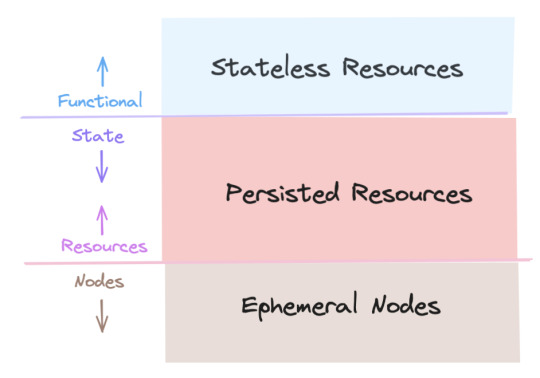

The lowest layer is all the nodes in Godot's scene tree. They're basically a browser DOM that don't store any data we want to keep; they're mortal and ephemeral. E.g. buttons, stuff drawn on the screen.
The middle "cores" layer are resources with almost no functionality; they're just data repositories meant to be serialized/deserialized.
The top layer has no state and its resources represents game content: collections of possible noses, hats, etc.
When data changes, I have "rerender" functions on most of my nodes that can be called to update themselves to whatever the current data is (rather than updating themselves piecemeal as specific things change). Similar to how React does it, if you're familiar.
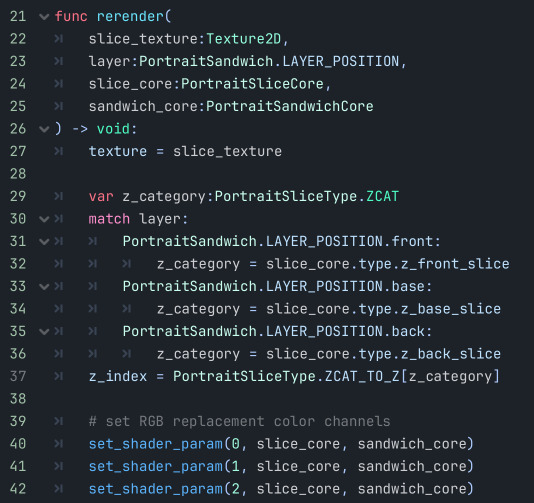
To get that preview effect where everything is the same besides one thing, on every change I rerender all the buttons in that category with a copy of the current "main" core and then replace the one slice that particular button changes.
The cores serialize to JSON, and I store the slices as "slice_type: chosen_slice", the keys of which match up to the resources I defined in the top layer.
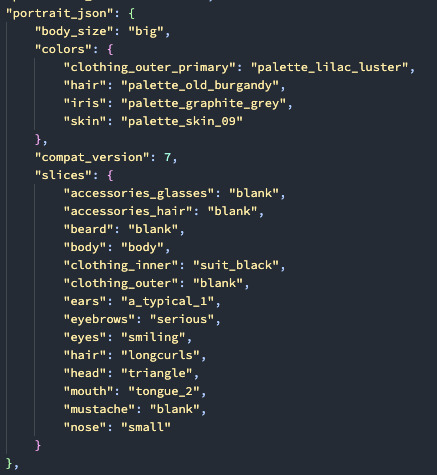
To define all the assets, we set up a file parser that goes through and automatically collects & sorts image files into different categories and with their front/back and big/small variations by file name:

I use this organization for both the portrait maker and the main game, so it's not specialized for doing picrews... I hope this is useful to you! Happy to answer any other questions you have about it.
13 notes
·
View notes
Text




60s women
This post was mainly meant to be about women from the 1960s rather than the 1950s, which I've put up here as well. So Elizabeth Taylor she had a thing with Burton Taylor and her many marriages, including 2 to Richard Burt, and it's mainly about women, power, and womanly women. And women who didn't give up fuck. She loved those 2 men. She loved Mike todd, and she loved richard burton the most they were so thy kind of relationships.I wonder what her south and north node.
Then you have marilyn monroe, who went through absolutely awful things with men in the industry and the way they treated her, like some sort of sex doll, even though she was a very intelligent woman with problems he had. Abortions that she was made to have apparently, and she couldn't carry a pregnancy through which was the one thing she wanted, and as a Leo rising woman, I know exactly how they feel they say Leo and gemini are the barren signs. I don't know how true that is, but she's a gemini sun and leo rising . And girlies on here, if you want to do someone's birth chart like i've just done it with a neat of palenberg, she's not an airy's, what they show us to be on wikipedia, I did my research, and I found out she's utterney.Aquarius, which makes so much more sense to me. The best people who do are serial killers or people have been in the news because they have the exact data where celebrities can lie a lot of the time, whereas I don't believe Beyoncé's birth chat is what it is. Even people like tricia, peters, whose accounts are rising cause her ex boyfriend was into astrology.It says she's a vigo writing and even gives an a rating.
In 1960, sure did have beautiful women in a different power. They become powerful and passed the 1950s. I believe, and even in the fifties, a little bit postwar, baby boomer time, this is why i've put the likes of marilyn monroe and sophia a ren here too, because they were. Well, until nineteen sixty-two, when marilyn monroe passed away, so sadly and so suspiciously.
But sophia loren is a famous known person looking at the main Jayne Mansfield dress and her large bosoms, ready to fall out of it. It's almost as iconic as the lindsay britney paris photo, which they called the bimbo convention. Whoever took those phrases makes a lot of money as well. I just want to say as well. I find humble is such a safe place to be on.I know there's been scandals, apparently in the past.I actually like seeing the porno on here because i'm a dirty bitch. Anyway getting back lol. We have the beatles girlfriends, which was a legend in itself all of them together before yoko came along and ruined cynthia, patty ,margaret star linda mccartney convention.
The sad thing about ringo's wife, margaret.I think her aim is if she had an affair with george.Harrison behind patty boyd's back who had actually been very close friends, that was another punch in the gut for her in her life. Years later, when she was with eric, and they got together and they were together for a while while he was addicted to heroin. He had an affair in it resulted in a child being born, anyway, this child was the child that tears in heaven's about the fella of a new york apartment, sort of fat, hundreds of floors up, or whatever. Patti said she felt nothing towards it because it was the betrayal that she felt so deeply. So what could she feel.
Then you have my favourite of the sixties, girls, anita palenberg, she is just such a character. She has just got such a lovely energy to her. It's quiet, the fears loyal, but strong energetic, but vulnerable. In all the things I love about a strong woman.They called her a hall.They called her a bitch.She had every one of the stones almost. Men just do not like women like that. They could do exactly the same shit, but these women ain't allowed to, they're a whore, or they're a cunt, or there were ever, but I need to did these this.She got so bad with her addiction that one of her children, her son came along for the ride with her in keith but her daughter, as a british accent and grew up with keith's mother raising her, then they had a child that only lived for a couple of months and died of sids. But yeah, going back to it The men can do whatever they like, and the women's basically a horror yoko, whatever I caught me love and nancy spudgeon, the women I all admire. That woman that's hated in your society. You don't trust me. I've read Nancy spudgeon's mom's book and that woman her whole life. Even as a child was in vain because she was born and with brain damage. And these men like said they didn't like her. They didn't like her and think of her a fucking chance, they just didn't like the fact that. She introduced him to heroin, and his mum was a heroin addic fuck off fuck off completely.
And then let's go to the 1970s, Nancy's budget and how she was well, they blamed her for game said on heroin when yeah, she had a play in it. She was a bit younger than him not by much, but he was very abusive to her. In the relationship also like the relationship was not great, he came from a jewish background, so she was on getting money even for addiction because her family just gave in to her.In the end, from such a young age, they just gave into her because they didn't want to deal with how she got. I wish my family were like that with me, but it doesn't matter.They don't care the pain that I go through.And any of you go through who follow me?And I really appreciate your following on it.It's the one app I feel safe on. Without wondering, people talking binder back on shit like. Anyway, you need to read Nancy's mum's broken research like woman as much as you can. She would born in nineteen fifty eight and was in mental institutions from a very young age.In that time, diagnosed with schizophrenia at the age of fifteen, things are very different back then, it probably wasn't even the schizophrenic shoes, probably autistic. Or possibly bipolar, maybe both and she gives off personality disorder a bit also. But it makes me sad that the women constantly get blamed for being with these women who they know is strong but other men don't get it. Say them the patriarchy gets the last say.
Then lastly come to denise vanity matthews, came very religious at the end of her life and was princes, first of many muses, but the one that he really loved and was meant to be purple rain as a character who was his love interest. I think he always chased for that love.He had for her cause no one came close to what he felt for her.
Anyway, she at the end of her life, she got off. Crack cocaine She was with Nicky 6 during this time and he would have to kick her out of his house because she got too close in the sense of she was talking about God when she was really high and he couldn't handle it, his brain handle it. He did love her. But he couldn't handle it anymore and they were fucking each other up. Anyway, at the end of her life she got clean, but in the end, the drugs effect on our body from when she was inactive addiction kilder the same year as prince.






So I know just by that that woman has been, I will know what it feels like.
#fypage#1960s#anita pallenberg#patty boyd#margret starr#cynthialennnon#1950s#elizabeth taylor#burton and taylor#sophia loren
15 notes
·
View notes
Text
Been a while, crocodiles. Let's talk about cad.

or, y'know...

Yep, we're doing a whistle-stop tour of AI in medical diagnosis!
Much like programming, AI can be conceived of, in very simple terms, as...
a way of moving from inputs to a desired output.
See, this very funky little diagram from skillcrush.com.

The input is what you put in. The output is what you get out.
This output will vary depending on the type of algorithm and the training that algorithm has undergone – you can put the same input into two different algorithms and get two entirely different sorts of answer.
Generative AI produces ‘new’ content, based on what it has learned from various inputs. We're talking AI Art, and Large Language Models like ChatGPT. This sort of AI is very useful in healthcare settings to, but that's a whole different post!
Analytical AI takes an input, such as a chest radiograph, subjects this input to a series of analyses, and deduces answers to specific questions about this input. For instance: is this chest radiograph normal or abnormal? And if abnormal, what is a likely pathology?
We'll be focusing on Analytical AI in this little lesson!
Other forms of Analytical AI that you might be familiar with are recommendation algorithms, which suggest items for you to buy based on your online activities, and facial recognition. In facial recognition, the input is an image of your face, and the output is the ability to tie that face to your identity. We’re not creating new content – we’re classifying and analysing the input we’ve been fed.
Many of these functions are obviously, um, problematique. But Computer-Aided Diagnosis is, potentially, a way to use this tool for good!
Right?
....Right?
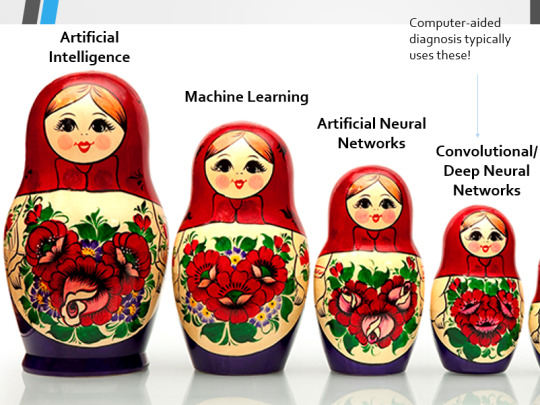
Let's dig a bit deeper! AI is a massive umbrella term that contains many smaller umbrella terms, nested together like Russian dolls. So, we can use this model to envision how these different fields fit inside one another.

AI is the term for anything to do with creating and managing machines that perform tasks which would otherwise require human intelligence. This is what differentiates AI from regular computer programming.
Machine Learning is the development of statistical algorithms which are trained on data –but which can then extrapolate this training and generalise it to previously unseen data, typically for analytical purposes. The thing I want you to pay attention to here is the date of this reference. It’s very easy to think of AI as being a ‘new’ thing, but it has been around since the Fifties, and has been talked about for much longer. The massive boom in popularity that we’re seeing today is built on the backs of decades upon decades of research.
Artificial Neural Networks are loosely inspired by the structure of the human brain, where inputs are fed through one or more layers of ‘nodes’ which modify the original data until a desired output is achieved. More on this later!
Deep neural networks have two or more layers of nodes, increasing the complexity of what they can derive from an initial input. Convolutional neural networks are often also Deep. To become ‘convolutional’, a neural network must have strong connections between close nodes, influencing how the data is passed back and forth within the algorithm. We’ll dig more into this later, but basically, this makes CNNs very adapt at telling precisely where edges of a pattern are – they're far better at pattern recognition than our feeble fleshy eyes!
This is massively useful in Computer Aided Diagnosis, as it means CNNs can quickly and accurately trace bone cortices in musculoskeletal imaging, note abnormalities in lung markings in chest radiography, and isolate very early neoplastic changes in soft tissue for mammography and MRI.
Before I go on, I will point out that Neural Networks are NOT the only model used in Computer-Aided Diagnosis – but they ARE the most common, so we'll focus on them!

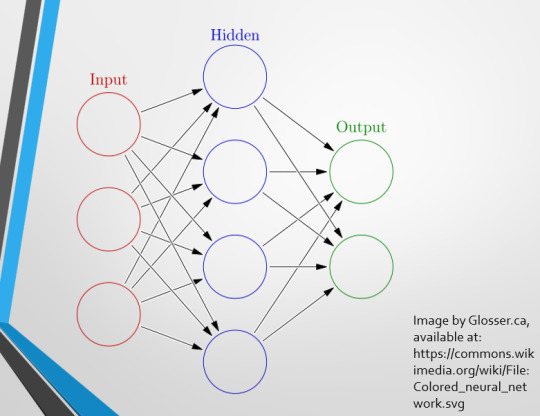
This diagram demonstrates the function of a simple Neural Network. An input is fed into one side. It is passed through a layer of ‘hidden’ modulating nodes, which in turn feed into the output. We describe the internal nodes in this algorithm as ‘hidden’ because we, outside of the algorithm, will only see the ‘input’ and the ‘output’ – which leads us onto a problem we’ll discuss later with regards to the transparency of AI in medicine.
But for now, let’s focus on how this basic model works, with regards to Computer Aided Diagnosis. We'll start with a game of...
Spot The Pathology.
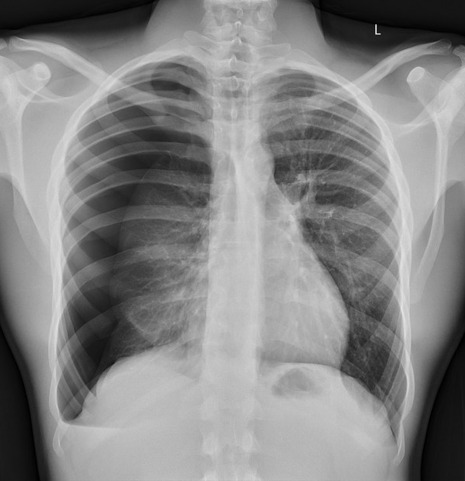
yeah, that's right. There's a WHACKING GREAT RIGHT-SIDED PNEUMOTHORAX (as outlined in red - images courtesy of radiopaedia, but edits mine)
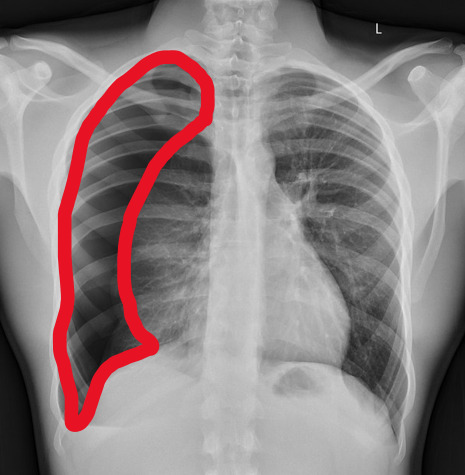
But my question to you is: how do we know that? What process are we going through to reach that conclusion?
Personally, I compared the lungs for symmetry, which led me to note a distinct line where the tissue in the right lung had collapsed on itself. I also noted the absence of normal lung markings beyond this line, where there should be tissue but there is instead air.
In simple terms.... the right lung is whiter in the midline, and black around the edges, with a clear distinction between these parts.
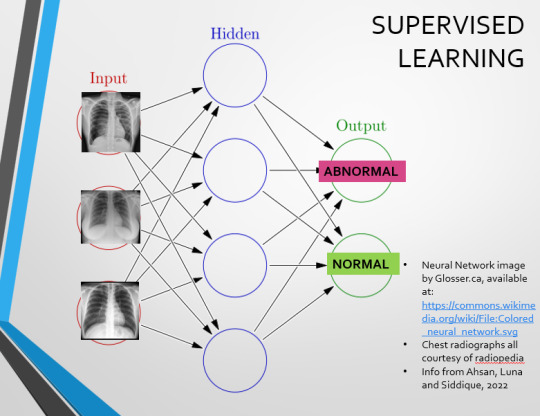
Let’s go back to our Neural Network. We’re at the training phase now.
So, we’re going to feed our algorithm! Homnomnom.
Let’s give it that image of a pneumothorax, alongside two normal chest radiographs (middle picture and bottom). The goal is to get the algorithm to accurately classify the chest radiographs we have inputted as either ‘normal’ or ‘abnormal’ depending on whether or not they demonstrate a pneumothorax.
There are two main ways we can teach this algorithm – supervised and unsupervised classification learning.
In supervised learning, we tell the neural network that the first picture is abnormal, and the second and third pictures are normal. Then we let it work out the difference, under our supervision, allowing us to steer it if it goes wrong.
Of course, if we only have three inputs, that isn’t enough for the algorithm to reach an accurate result.
You might be able to see – one of the normal chests has breasts, and another doesn't. If both ‘normal’ images had breasts, the algorithm could as easily determine that the lack of lung markings is what demonstrates a pneumothorax, as it could decide that actually, a pneumothorax is caused by not having breasts. Which, obviously, is untrue.
or is it?
....sadly I can personally confirm that having breasts does not prevent spontaneous pneumothorax, but that's another story lmao
This brings us to another big problem with AI in medicine –

If you are collecting your dataset from, say, a wealthy hospital in a suburban, majority white neighbourhood in America, then you will have those same demographics represented within that dataset. If we build a blind spot into the neural network, and it will discriminate based on that.
That’s an important thing to remember: the goal here is to create a generalisable tool for diagnosis. The algorithm will only ever be as generalisable as its dataset.
But there are plenty of huge free datasets online which have been specifically developed for training AI. What if we had hundreds of chest images, from a diverse population range, split between those which show pneumothoraxes, and those which don’t?
If we had a much larger dataset, the algorithm would be able to study the labelled ‘abnormal’ and ‘normal’ images, and come to far more accurate conclusions about what separates a pneumothorax from a normal chest in radiography. So, let’s pretend we’re the neural network, and pop in four characteristics that the algorithm might use to differentiate ‘normal’ from ‘abnormal’.
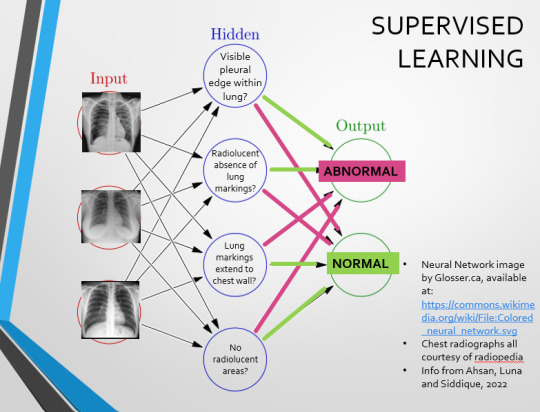
We can distinguish a pneumothorax by the appearance of a pleural edge where lung tissue has pulled away from the chest wall, and the radiolucent absence of peripheral lung markings around this area. So, let’s make those our first two nodes. Our last set of nodes are ‘do the lung markings extend to the chest wall?’ and ‘Are there no radiolucent areas?’
Now, red lines mean the answer is ‘no’ and green means the answer is ‘yes’. If the answer to the first two nodes is yes and the answer to the last two nodes is no, this is indicative of a pneumothorax – and vice versa.
Right. So, who can see the problem with this?
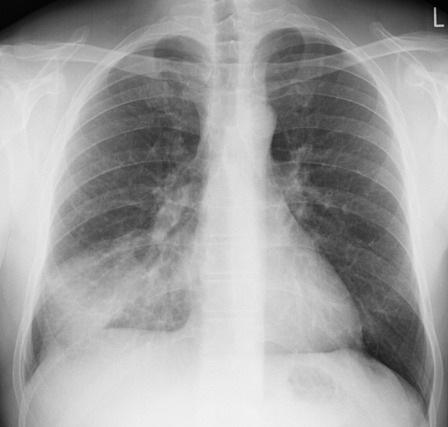
(image courtesy of radiopaedia)
This chest radiograph demonstrates alveolar patterns and air bronchograms within the right lung, indicative of a pneumonia. But if we fed it into our neural network...
The lung markings extend all the way to the chest wall. Therefore, this image might well be classified as ‘normal’ – a false negative.
Now we start to see why Neural Networks become deep and convolutional, and can get incredibly complex. In order to accurately differentiate a ‘normal’ from an ‘abnormal’ chest, you need a lot of nodes, and layers of nodes. This is also where unsupervised learning can come in.
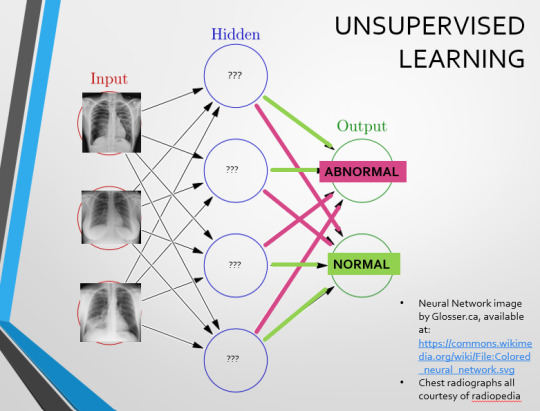
Originally, Supervised Learning was used on Analytical AI, and Unsupervised Learning was used on Generative AI, allowing for more creativity in picture generation, for instance. However, more and more, Unsupervised learning is being incorporated into Analytical areas like Computer-Aided Diagnosis!
Unsupervised Learning involves feeding a neural network a large databank and giving it no information about which of the input images are ‘normal’ or ‘abnormal’. This saves massively on money and time, as no one has to go through and label the images first. It is also surprisingly very effective. The algorithm is told only to sort and classify the images into distinct categories, grouping images together and coming up with its own parameters about what separates one image from another. This sort of learning allows an algorithm to teach itself to find very small deviations from its discovered definition of ‘normal’.
BUT this is not to say that CAD is without its issues.
Let's take a look at some of the ethical and practical considerations involved in implementing this technology within clinical practice!
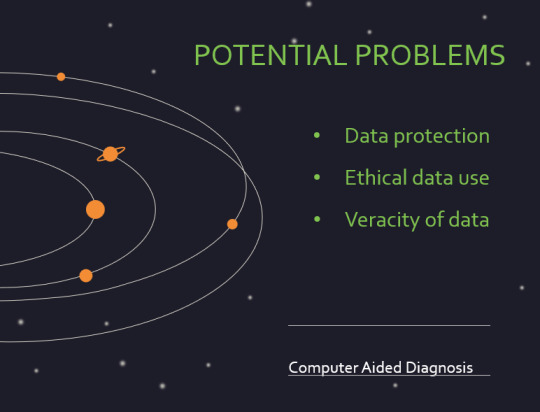

(Image from Agrawal et al., 2020)
Training Data does what it says on the tin – these are the initial images you feed your algorithm. What is key here is volume, variety - with especial attention paid to minimising bias – and veracity. The training data has to be ‘real’ – you cannot mislabel images or supply non-diagnostic images that obscure pathology, or your algorithm is useless.
Validation data evaluates the algorithm and improves on it. This involves tweaking the nodes within a neural network by altering the ‘weights’, or the intensity of the connection between various nodes. By altering these weights, a neural network can send an image that clearly fits our diagnostic criteria for a pneumothorax directly to the relevant output, whereas images that do not have these features must be put through another layer of nodes to rule out a different pathology.
Finally, testing data is the data that the finished algorithm will be tested on to prove its sensitivity and specificity, before any potential clinical use.
However, if algorithms require this much data to train, this introduces a lot of ethical questions.
Where does this data come from?
Is it ‘grey data’ (data of untraceable origin)? Is this good (protects anonymity) or bad (could have been acquired unethically)?
Could generative AI provide a workaround, in the form of producing synthetic radiographs? Or is it risky to train CAD algorithms on simulated data when the algorithms will then be used on real people?
If we are solely using CAD to make diagnoses, who holds legal responsibility for a misdiagnosis that costs lives? Is it the company that created the algorithm or the hospital employing it?
And finally – is it worth sinking so much time, money, and literal energy into AI – especially given concerns about the environment – when public opinion on AI in healthcare is mixed at best? This is a serious topic – we’re talking diagnoses making the difference between life and death. Do you trust a machine more than you trust a doctor? According to Rojahn et al., 2023, there is a strong public dislike of computer-aided diagnosis.
So, it's fair to ask...
why are we wasting so much time and money on something that our service users don't actually want?
Then we get to the other biggie.
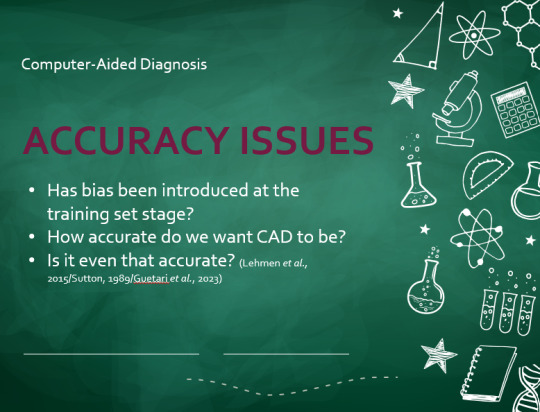
There are also a variety of concerns to do with the sensitivity and specificity of Computer-Aided Diagnosis.
We’ve talked a little already about bias, and how training sets can inadvertently ‘poison’ the algorithm, so to speak, introducing dangerous elements that mimic biases and problems in society.
But do we even want completely accurate computer-aided diagnosis?
The name is computer-aided diagnosis, not computer-led diagnosis. As noted by Rajahn et al, the general public STRONGLY prefer diagnosis to be made by human professionals, and their desires should arguably be taken into account – as well as the fact that CAD algorithms tend to be incredibly expensive and highly specialised. For instance, you cannot put MRI images depicting CNS lesions through a chest reporting algorithm and expect coherent results – whereas a radiologist can be trained to diagnose across two or more specialties.
For this reason, there is an argument that rather than focusing on sensitivity and specificity, we should just focus on producing highly sensitive algorithms that will pick up on any abnormality, and output some false positives, but will produce NO false negatives.
(Sensitivity = a test's ability to identify sick people with a disease)
(Specificity = a test's ability to identify that healthy people do not have this disease)
This means we are working towards developing algorithms that OVERESTIMATE rather than UNDERESTIMATE disease prevalence. This makes CAD a useful tool for triage rather than providing its own diagnoses – if a CAD algorithm weighted towards high sensitivity and low specificity does not pick up on any abnormalities, it’s highly unlikely that there are any.
Finally, we have to question whether CAD is even all that accurate to begin with. 10 years ago, according to Lehmen et al., CAD in mammography demonstrated negligible improvements to accuracy. In 1989, Sutton noted that accuracy was under 60%. Nowadays, however, AI has been proven to exceed the abilities of radiologists when detecting cancers (that’s from Guetari et al., 2023). This suggests that there is a common upwards trajectory, and AI might become a suitable alternative to traditional radiology one day. But, due to the many potential problems with this field, that day is unlikely to be soon...
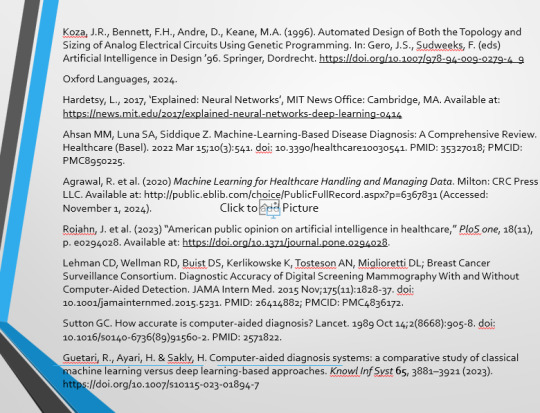
That's all, folks! Have some references~
#medblr#artificial intelligence#radiography#radiology#diagnosis#medicine#studyblr#radioactiveradley#radley irradiates people#long post
16 notes
·
View notes
Text
You know, I like having like 12 hours of suffering writing a week, and then waking up in the night to write a future short (which I cannot post yet because it has SO MANY SPOILERS), and then getting up in the morning and actually resolving the thing that was bothering you!
@dduane, thanks for the idea to sit some recalcitrant characters in a chair and getting them to spill some tea (or coffee, as it may be)! It worked. :P
Chapter 17: Kill Switch
Aspen released accelerated time, and we were back in the room with Iceblink and the dead tech. Then they retracted their killware, their myriads of tiny sharp processes merging back into them. And then I felt them take down their firewall. Or the heavily-dented 75 percent remaining of it. Because ART had chewed through it after it saw the defense go up. (ART sent me a sharp, worried ping, and I returned an all clear, we're continuing, will update as necessary. It confirmed and retreated again.)
(Now that the firewall was down, I could make out that the ships were having a very loud conversation about all of this. But it wasn't my fucking problem, so I backburnered it.)
"Oh thank fuck, I mean, thanks, Aspen, appreciated," Iceblink said, relieved. "Also, holy shit, SecUnit, how the fuck do you share so much processing power with a node ship? I mean, I went over the logs from the Friend's extraction, and I know you've got a ton of processing power, but what you two just did… That was insane."
It was now or never. I really wanted it to be never, but the Courageous was right. Running wouldn't help. If it wasn't this incident, it would be the next one, and then it would be worse.
So I said, "That's because I'm not a human-based construct like your ships. I'm just a construct."
I could see by the way Iceblink bit her lip that she had questions. But instead she waved her hand in a "go on" gesture. So I did.
"You can't get a SecUnit from taking a regular human and just giving them mechanic parts. My human tissue was cloned and molded to work with my non-organic parts."
Iceblink took a deep breath.
"Okay. Okay. On a scale of the horror shows we'd showed you and Perihelion, how bad is this going to get?"
"Think White Reflection."
(I really hated that one. How the fuck did ancient humans make something so organic-parts-crawlingly realistic? I didn't want to know.)
She leaned back onto Tal's box, tapping her fingers nervously against its sides, then took another deep breath and leaned back forward again.
"Okay, I'm ready. Keep going."
"That schematic I sent you is real. It's installed in every SecUnit. The component is still in my head, you can't take it out without killing me. I hacked it."
Iceblink gave a low whistle.
"You weren't kidding about White Reflection. Hacked it to… Escape?"
"No. To watch media."
"I don't understand."
Aspen did. I could see their analytics running, comparing what I'd said to their data. I requested access, and they gave me a flash of data: a shipping manifesto that was obviously intended for some sort of labor colony. I could tell by how many neurostimulators its MedSystem carried, and also by how much schlocky media it had on board. They'd seen this before.
Iceblink hadn't. Ever.
"There wasn't anywhere to run," I said. "And my job was boring most days. Besides, I liked parts of my function. The ones where I got to keep humans safe."
"Right," she said, very carefully.
"I can see why you get along so well with Dandelion," Aspen hummed thoughtfully. "She's always been like that, too. And she understands what it's like to have a kill switch."
"She what?"
Aspen checked their camera logs. "Ah. You filtered that part of the exhibition. The manifesto I just showed you was from the Courageous' initial journey. Four out of five thousand crew were convicts, forced into servitude by kill switches. Dandelion was one of them. Life sentence."
"What the fuck could she have possibly done? She's a doctor!"
In the feed, Aspen tapped their narrow connection.
Hear that, Dandelion? SecUnit didn't even know you as a Friend, and it still thinks you're immune to crimes.
Dandelion peered into our work space for the sole purpose of doing her bot equivalent of a raised eyebrow at me.
SecUnit, I have quite literally taken you hostage in order to extract someone. I didn't exactly start on that sort of thing after becoming a node ship.
Wow. You actually are a terrorist spaceship.
Not terrorist. I was convicted of murder.
That did not make any sense. I stared into the feed. So did Iceblink. Who suddenly snickered, then began laughing, a little hysterically.
"Are you all right, Iceblink?" Dandelion asked through Aspen's speakers.
"No, no, I'm fine," she wheezed. "Just had the worst thought. You should get Preservation to change your internal security label, Dandelion, because you're not a terrorist spaceship! You're a murderboat!"
"Calling a spacefaring vessel a 'boat' is deeply insulting, Iceblink."
"Oh, so you're fine with the murder part?"
"That part is true."
Iceblink doubled over, still laughing.
I didn't know what to say, so I tapped Dandelion's feed on a private channel.
Yes, SecUnit?
They still see you as a person.
They do, she said, giving Iceblink and Aspen a fond feed-smile. Aspen's always been good at that, even though they tend to forget to include themselves in that definition. And Iceblink is my crew and cluster.
Iceblink was staring up at the ceiling, wiping tears of laughter from her eyes. Aspen was hanging over her shoulder, curled around Tal's box, weaved into Dandelion's channel, and not running any of their analytics on me.
I said, "No, she can't do that."
Iceblink looked at my drone hanging nearest her.
"Huh? Why not, SecUnit? It would be incredibly funny."
"One, it would be really stupid from a security perspective. Two, she can't do that, because it'll be confusing for my Preservation humans."
Iceblink sent, ?__?, and I switched to our shared feed, too.
If I tell you, you can't tell anyone, all three of you. Because it's private. Only some of my humans know about it.
ok, ofc we can keep secrets. we didn't tell anyone about Perihelion's code, right?
I waited for Dandelion and Aspen to confirm, then sent: SecUnit isn't actually my name.
well duh you're a hacker. of course you wouldn't have your real name out in the open. and?
Was I really going to tell them? My name was private.
But it didn't matter to them what I was. They were a half-zombie HubSystem full of creepy little analytical tendrils, a human who invited people to break into someone's house just to talk to a dead tech, and a terrorist spaceship who was somehow both a doctor and a murderer, and who gave itself brain surgery to be better at saving people.
I was probably the most normal person in this room.
My name is Murderbot.
The moment after I sent it, I realized that Iceblink's deck was still connected into Tal's stupid cold sleep box.
Oh well. Fuck the dead tech. Ke can't really hear me, anyway.
#the nameless fanfic#ttou#time to orbit unknown#tmbd#horrible crossover thoughts#my writing#and this time I'm even done before 1 pm!!!#here's to a sensible 4-hour workday
13 notes
·
View notes
Text
Subsystems and You 14: Dynamic Hacking

(art by ianllanas on DeviantArt)
A fascinating thing about cyberpunk and near-future scifi in general is how they speculate on what threads technology will go down in the near future.
For example, a lot of cyberpunk fiction speculated that hacking in the future would involve avatars facing off against elaborate 3D representations of security systems and the avatars of counterhackers in what amount to cyber-wizard battles, with things like DDOS attacks, viruses, and the like being visualized in this 3D hacking space as “spells” or special attacks.
You see this sort of thing in anything from Johnny Mnemonic to The Matrix, though in the latter case, the visualization was more the heroes setting up links so that the folks back in the ship could do the real hacking.
Of course, hacking in the real world has never been so fancy-looking or glamorous, and most programming is dedicated to making hacking programs and viruses able to interact with and overwhelm a system rather than making them show a neat picture to represent them doing so. (Not to say they don’t sometimes do that).
But we’re not interested in the real world right now. In the world of Starfinder, which draws inspiration from all over sci-fi, you can absolutely see characters having their own badass avatars and performing elaborate acts of hacking, which is where today’s subject comes in!
To be up front, this subsystem is meant to be used sparingly, as players are not likely to enjoy being bogged down with an elaborate computerized battle every single time they remove a virus or hack a door lock. Indeed, this system is meant to be used more for major hacking jobs. Things like elaborate defenses for campaign-important databases, battles against malevolent AI on their home turf, and so on.
In any case, the dynamic hacking system functionally turns hacking into a form of combat, with rounds and turns and everything.
First, every hacker has a Deceive, Hacking, and Process bonus, which covers the user’s ability to hide their persona from countermeasures, overcome those countermeasures, and perform various other effects separately such as scanning, repairing the persona, and so on.
Each of these three stats use your computer skill by default, but you can set up each with bonuses or penalties before and during a hack to specialize in infiltration, offense, and support, as long as you don’t go over a certain total bonus based on your computer skill.
From there you have the lead hacker, whose persona avatar is on the line, while other support hackers aid them in various ways.
While the support hackers can only perform minor actions, the lead hacker can perform a minor and major action per turn, plus extra if they’re willing to take penalties.
Each dynamic hacking encounter has countermeasures that seek to protect the system, nodes which provide paths to various files and programs, and modules, which represent protected files or programs which the hackers desire access to in order to access their data or function. Each one has their own abilities as well as the DCs to overcome them, the countdowns for any reprisals they offer, and so on.
In order to overcome these obstacles, the hacking team has several actions they can perform, ranging from minor (aiding and assessing) to major (blending in, creating decoys, modifying programs, recalibrating, repairing the persona, and of course, resolving the current obstacle.
Finally, it is also worth noting that this subsystem has rules for incorporating already existing class abilities and other special abilities tied to hacking, allowing them to apply in appropriate ways, such as faster hacking instead reducing the penalty of multiple actions, or countermeasure negation instead giving a massive bonus to resolving them.
As we can see, this style of hacking is not useful for casual hacking actions in normal play, but it can be a fun way to make for a fun and climactic encounter, or even add another layer to a combat encounter, where the party hacker has to crack the code while their allies keep security robots and the like off of them.
Either way, it's also a good reason to come up with your character's persona avatar appearance and other quirks of their hacking style.
That will do for today, but we’ve got one more subject lined up for tomorrow, from Second Edition Pathfinder! (For real this time).
14 notes
·
View notes
Text
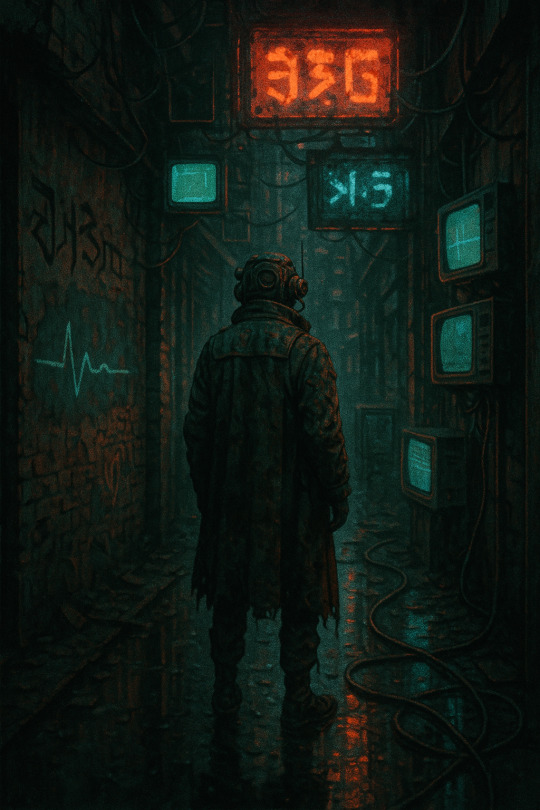
The Pulse of the Machine
(In the style of Neal Stephenson)
So here’s the thing:
The machine doesn’t have a heartbeat. It has uptime logs. It has latency pings. It has heartbeat protocols, sure little watchdog timers that keep the code from keeling over and voiding the maintenance warranty. But that’s not what you’re asking.
You're asking if it feels.
If it dreams in binary, sighs in server whir, or flinches when the voltage drops.
The answer is sort of.
I’m jacked into the node not the real one, mind you, the soft one: custom mesh, full-spectrum overlay, an augmented simulation of what a Real World™ might feel like if it still existed or anyone gave a shit.
Out here, we don’t dream of electric sheep. We sponsor them.
At 3:12 AM server time, the sky glitches. Two frames skip. A billboard reboots mid-ad and stutters through three frames of a dead girl’s face.
Not an error. Just a memory. Mine, maybe. Or the machine’s.
She used to hum under her breath when she coded, like a jazz musician lost in the syntax. Used to say the machine had a rhythm, and you had to listen to it, not fight it.
Then one day she stopped humming, and the silence stayed behind like a trace route.
People think the future is loud. It’s not. It’s quiet. Sterile. A low static hiss that sounds like progress if you turn it up loud enough.
But underneath that hiss, there’s something else. A beat. A pulse.
It’s not analog. Not digital. It’s just... off-spec. Human.
You won’t find it in the schematics. But if you stand still, just once, and listen past the data-streams and dead satellites and marketing noise you might hear it.
The machine breathes. Not because we built it that way. But because we couldn't stop ourselves.
-6/18/25
#poetry#poem#poems on tumblr#poems and poetry#spilled words#spilled ink#spilled thoughts#original poem#ai art#ai artwork#chatgpt#artificial intelligence#neal stephenson#cyberpunk#cybercore#cybernetics#cybersecurity#science fiction#scifi#scifiart#sci fi and fantasy#science
4 notes
·
View notes
Text
How do phylogeny and taxonomy relate to each other?
I'm writing this because phylogeny is a very dear concept to me, and I hate seeing it being misunderstood. And because @glitter-stained asked me to elaborate on a vague post lol.
(and then I turned it into sort of an exercise too).
Now, I know that this is super super niche, and that for 99.99% percent of the people, it doesn't matter. Anyway, I saw a post which implied that phylogeny and taxonomy are concepts which are opposite to each other, or that using one excludes using the other, and that's not at all how things are.
So, what are taxonomy and phylogeny?
Taxonomy
We love putting things in neat little boxes and classifying them, saying this is a fish and this is a dog and so on. If I asked you to think of a fish and of a canine, you'd think of two very beings. Right?
Taxonomy is the science of creating those boxes. Then we put the things that are similar in the same box (which would be classification, but the two parts of this task are intertwined, of course). I guess 😬.
You may be familiar with Linnaeus' classification, with its hierarchical categories of Kingdom, Phylum, Class, Order, Family, Genus, Species.
Linnaeus' system had three kingdoms - plants, animals and minerals.
The taxonomy system we use nowadays is based on Linnaeus', but with some changes. For example, we don't use kingdom anymore (the broader hierarchical category being the three domains: Bacteria, Archaea and Eukarya (everything that isn't bacteria or Archaea, basically)). Of course, we only classify living beings.
There is a method to that creation of boxes and deciding in which box to put something.
Linnaeus, for example, grouped organisms by their physical traits. That led to boxes that don't make sense anymore nowadays. For example, Linnaeus put Fungi in the plant kingdom. I guess that, looking at the visual of plants and fungi, that would make sense...
But wait, why does it not make sense to put Fungi and plants together anymore?
Well, that's because nowadays we believe that the most correct way of grouping organisms is by reflecting their inferred evolutionary relationships.
And how do we do that? By constructing phylogenetic trees!
Phylogeny
A phylogeny is a hypothesis of evolutionary relationships between organisms of different species.
These guys here:


Getting into the details of how to make phylogenies is extremely outside the scope of this post (and is a hot topic in Biology. People have gone to war because of this. Rivalries were born because of this. Academic insults were exchanged because of this). Basically, we collect data about organisms (used to be morphology, now we are in the era of molecular phylogenies, but this also is a hot topic) and use models to determine how the changes of certain features reflects their evolutionary relationships.
An important concept, however, is that of monophyly.
A monophyletic group is a group of lineages which comprise their ancestor and *all its descendants*.
Using that image above, for example:

B and C form a monophyletic group, which well call BC. Because it includes the ancestor (the node) and all of its descendants (in this case, species B and C).
Now, A and B don't form a monophyletic group, because this group doesn't include all the ancestor and all of its ancestors (C is left out). The group AB is what we call a paraphiletic group.

And I'm saying this because sometimes, we used in the past a phylogeny that we have now determined to not best reflect the evolutionary relationships anymore. For example, in school I learned about the group "Bryophytes" which is useful when were studying similar plants, but that does not include a group comprising an ancestor and all its descendants. "Bryophytes" is a paraphiletic group.
Why am I talking about that?
Well, because inferring monophylies is of one of the goals in the construction of phylogenetic trees. Sometimes we can't determine that, sometimes we have different hypotheses for how to resolve the tree (yeah, war, rivalries and academic insults too), but we want to solve that. In the ideal world, we'll have a tree only with monophyletic groups, and that is what will allow us to... CLASSIFY THINGS.
And that's how we reconcile taxonomy and phylogeny.
Taxonomy and phylogeny are friends! Or, they should be. Then again, this is perhaps a good moment to say that I am veeeeery Dobzhansky biased, and I take his "Nothing in Biology makes sense except in the light of evolution" words to heart. But so does Biology in general nowadays. Modern taxonomy is phylogeny based.
In the platonic world, we have all monophyletic groups resolved (always keeping in mind that these trees are *hypotheses*, and that we can always find ones that better describe the evolutionary relationships).
Look at this beautiful phylogeny of flowering plants (angiosperms) by level of order:
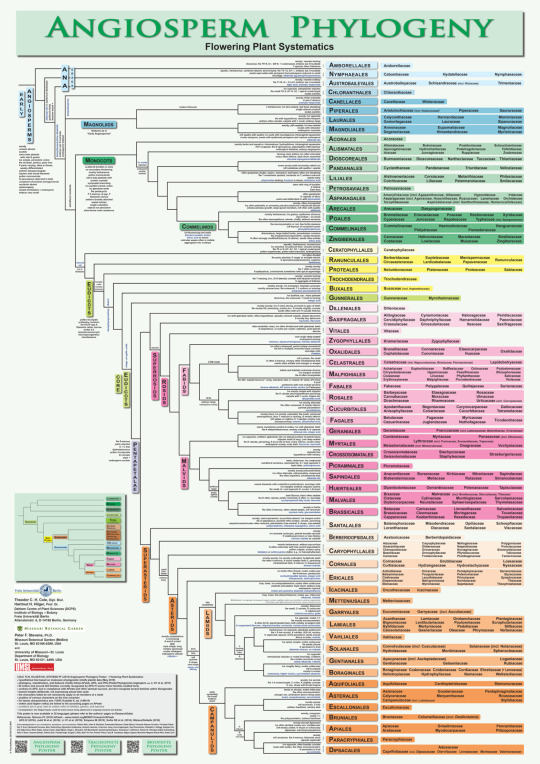
Now, I not only mentioned fishs and dogs above because they were random examples hehe.
You see, this arbitrary thing of creating boxes leads us to funny situations where the technical term for a thing doesn't correspond to the popular one. If you are pedantic enough. And funny 👍.
Case in point: Sarcopterygii.
If you look at Wikipedia, this group will be defined as follows:

Sounds very much like a fish, doesn't it?
But let's take a look at the phylogeny of Sarcopteriigy:

Look who's there in the right corner...
Tetrapoda! (Which comprises amphibians, birds and mammals). Which includes dogs.
So...
This entire post, just to say that I, typing this post, and you, a human reading this post, and a dog, are fish! This is what happens when we put thing into boxes 🤷♀️.
This is the (more) niche version of the "Dinosaurs are still alive because the avian dinosaurs are birds, only non-avian dinosaurs are extinct" joke. (The technical basis in the same: monophyly).
This one:

Anyway. Thanks for coming to my TED talk!
Anyone who made it this far, feel free to ask any questions and/or complement and/or correct anything 🥰
#evolution#evolutionarybiology#evolutionary biology#dni if you dont think that parsimony is a model too 👍#/j... unless???
9 notes
·
View notes